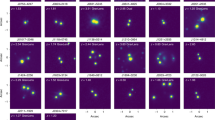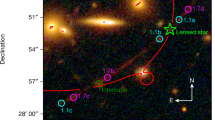Abstract
The objective prism plates from the UK Schmidt telescope taken under good seeing conditions can reach to about magnitude +20 and provide ideal material for studies of the distribution over the sky. We have carried out a detailed search of one of these plates centred on RA 11 h 40 min, dec. 11°00′ N in a preliminary investigation of QSO clustering on Scales up to several arc min. Most of the 200 or so QSO candidates noted during this search are emission line objects and definite QSOs but several show no obvious emission features and were selected solely on the basis of their noticeably blue continuum spectra. Subsequent high-resolution spectroscopic observations show that while some of these blue continuum objects are low redshift QSOs a significant fraction are white dwarfs and blue compact galaxies. Allowing for these misidentifications we estimate that a total of 200 QSOs (∼six QSOs per square degree) is a conservative upper estimate for the number of genuine QSOs to be found on this plate using our particular selection criteria. With a surface density of about six QSOs per square degree, pairings of QSOs at separations of several arc min are relatively common on a single plate and an individual pair is significant at the 1% level only at a separation of ≲ 10 arc. To be considered significant in its own right, a single association at separations of the order of 1 arc min requires a grouping of at least three objects. We report here the most striking association we noted satisfying these conditions, a compact group of four QSOs within a diameter of about 4 arc min. A physical association between two of the QSOs is suggested.
This is a preview of subscription content, access via your institution
Access options
Subscribe to this journal
Receive 51 print issues and online access
$199.00 per year
only $3.90 per issue
Buy this article
- Purchase on Springer Link
- Instant access to full article PDF
Prices may be subject to local taxes which are calculated during checkout
Similar content being viewed by others
References
Smith, H. E. et al. Astrophys. J. 215, 427 (1977).
Hayman, P. G., Hazard, C. and Sanitt, N. Mon. Not. R. astr. Soc. (in the press).
Walsh, D., Carswell, R. F. & Weymann, R. J. Nature 279, 381 (1979).
Author information
Authors and Affiliations
Rights and permissions
About this article
Cite this article
Hazard, C., Arp, H. & Morton, D. A compact group of four QSOs with two appearing physically associated. Nature 282, 271–272 (1979). https://doi.org/10.1038/282271a0
Received:
Accepted:
Issue Date:
DOI: https://doi.org/10.1038/282271a0
This article is cited by
-
Space fabric wrinkles: history of observational searches for exotic structures in the Universe
La Rivista del Nuovo Cimento (2021)
-
Double clusters and gravitational lenses
Nature (1986)
-
Recent discoveries of a supermass in the Universe
Nature (1986)
-
Observations of the cosmic background radiation near the double quasar 1146 + 111B,C
Nature (1986)
-
Is QSO1146+111B,C due to lensing by a cosmic string?
Nature (1986)
Comments
By submitting a comment you agree to abide by our Terms and Community Guidelines. If you find something abusive or that does not comply with our terms or guidelines please flag it as inappropriate.



